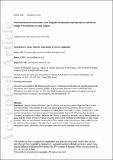Files in this item
From individuals to communities : how singleton invasive pine saplings lead to biodiversity change in the Brazilian Cerrado hotspot
Item metadata
| dc.contributor.author | Kortz, Alessandra R. | |
| dc.contributor.author | Silva Matos, Dalva M. | |
| dc.contributor.author | Magurran, Anne E. | |
| dc.date.accessioned | 2019-09-13T23:37:23Z | |
| dc.date.available | 2019-09-13T23:37:23Z | |
| dc.date.issued | 2018-09-14 | |
| dc.identifier | 254996341 | |
| dc.identifier | e2b9bef4-d12a-464e-a183-07e80a35ff37 | |
| dc.identifier | 85053452296 | |
| dc.identifier | 000448180400003 | |
| dc.identifier.citation | Kortz , A R , Silva Matos , D M & Magurran , A E 2018 , ' From individuals to communities : how singleton invasive pine saplings lead to biodiversity change in the Brazilian Cerrado hotspot ' , Journal of Vegetation Science , vol. Early View . https://doi.org/10.1111/jvs.12668 | en |
| dc.identifier.issn | 1100-9233 | |
| dc.identifier.other | crossref: 10.1111/jvs.12668 | |
| dc.identifier.other | ORCID: /0000-0002-0036-2795/work/48774871 | |
| dc.identifier.other | ORCID: /0000-0002-7473-1987/work/48774897 | |
| dc.identifier.uri | https://hdl.handle.net/10023/18475 | |
| dc.description | This work was funded by the Brazilian Ciência sem Fronteiras/Coordenação de Aperfeiçoamento de Pessoal de Nível Superior (CAPES) (1091/13-1), European Research Council (AdG BioTIME 250189and PoC BioCHANGE 727440), the Royal Society and the Brazilian Conselho Nacional de Desenvolvimento Científico e Tecnológico/CNPq (307839/2014-1). | en |
| dc.description.abstract | Questions: How do newly established species interact with existing assemblage members to alter local biodiversity? This question is especially topical given growing concerns about increased temporal turnover levels relative to background rates. Pine (Pinus spp.), a major invasive taxon in the southern hemisphere, is progressively dominating remaining fragments of the Brazilian savanna (Cerrado), a biodiversity hostpot. Because the Cerrado's diversity is linked to habitat heterogeneity we argue that the impact of these invasive singleton pines will be mediated by differences in local habitat structure. Here we use isolated invasive pines Pinus elliottii in the Cerrado as a study system to test the prediciton that changes in the diversity of native communities, in the presence of newly established exotic individuals, will be greatest in the dominant vegetation layer of a habitat. Location: Itirapina Ecological Station, southeast of Brazil. Methods: We used a stratified random survey in 5x5m pairs of plots invaded by a single pine individual each matched by control uninvaded plots; both shrub and grass vegetation layers were sampled in both habitats. In total, 300 plots were sampled, 114 in the shrub‐dominated campo sujo and 186 in the grass‐dominated campo úmido. Results: Over four hundred plant species were recorded. In both habitats, we detect marked shifts in species richness of the dominant vegetation layer. In line with our prediction, the nature of these changes is mediated by local habitat structure. We find significantly reduced species richness in the shrub layer of the shrub‐dominated habitat but elevated species richness in the grass layer of the grass‐dominated habitat in invaded sites (v. control). In the grass layer of campo úmido, pine initially decreases dominance thus allowing more species to colonize the plots. Conclusions: The shape of the diversity v. establishment time relationship is layer dependent, with a significant relationship between dominance/evenness and pine size in the grass layer but no relationship in the shrub layer. Our results show that, though complex, the consequences for local biodiversity of non‐native species establishment are not haphazard, and thus contribute to the understanding of species coexistence. | |
| dc.format.extent | 11 | |
| dc.format.extent | 925510 | |
| dc.language.iso | eng | |
| dc.relation.ispartof | Journal of Vegetation Science | en |
| dc.subject | α-diversity | en |
| dc.subject | Biodiversity change | en |
| dc.subject | Biological invasion | en |
| dc.subject | Invasion impact | en |
| dc.subject | Invasive species | en |
| dc.subject | Community ecology | en |
| dc.subject | Cerrado | en |
| dc.subject | Environmental heterogeneity | en |
| dc.subject | Habitat structure | en |
| dc.subject | Pinus elliottii | en |
| dc.subject | Species richness | en |
| dc.subject | Vegetation layer | en |
| dc.subject | QH301 Biology | en |
| dc.subject | DAS | en |
| dc.subject.lcc | QH301 | en |
| dc.title | From individuals to communities : how singleton invasive pine saplings lead to biodiversity change in the Brazilian Cerrado hotspot | en |
| dc.type | Journal article | en |
| dc.contributor.sponsor | European Research Council | en |
| dc.contributor.sponsor | European Research Council | en |
| dc.contributor.sponsor | The Royal Society | en |
| dc.contributor.institution | University of St Andrews. Marine Alliance for Science & Technology Scotland | en |
| dc.contributor.institution | University of St Andrews. Scottish Oceans Institute | en |
| dc.contributor.institution | University of St Andrews. Institute of Behavioural and Neural Sciences | en |
| dc.contributor.institution | University of St Andrews. St Andrews Sustainability Institute | en |
| dc.contributor.institution | University of St Andrews. Fish Behaviour and Biodiversity Research Group | en |
| dc.contributor.institution | University of St Andrews. Centre for Research into Ecological & Environmental Modelling | en |
| dc.contributor.institution | University of St Andrews. School of Biology | en |
| dc.contributor.institution | University of St Andrews. Centre for Biological Diversity | en |
| dc.identifier.doi | https://doi.org/10.1111/jvs.12668 | |
| dc.description.status | Peer reviewed | en |
| dc.date.embargoedUntil | 2019-09-14 | |
| dc.identifier.grantnumber | 250189 | en |
| dc.identifier.grantnumber | 727440 | en |
| dc.identifier.grantnumber | WM110141 | en |
This item appears in the following Collection(s)
Items in the St Andrews Research Repository are protected by copyright, with all rights reserved, unless otherwise indicated.

